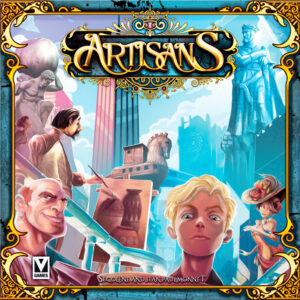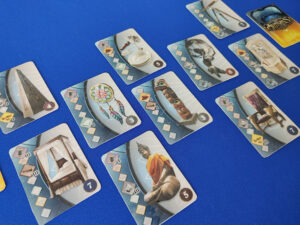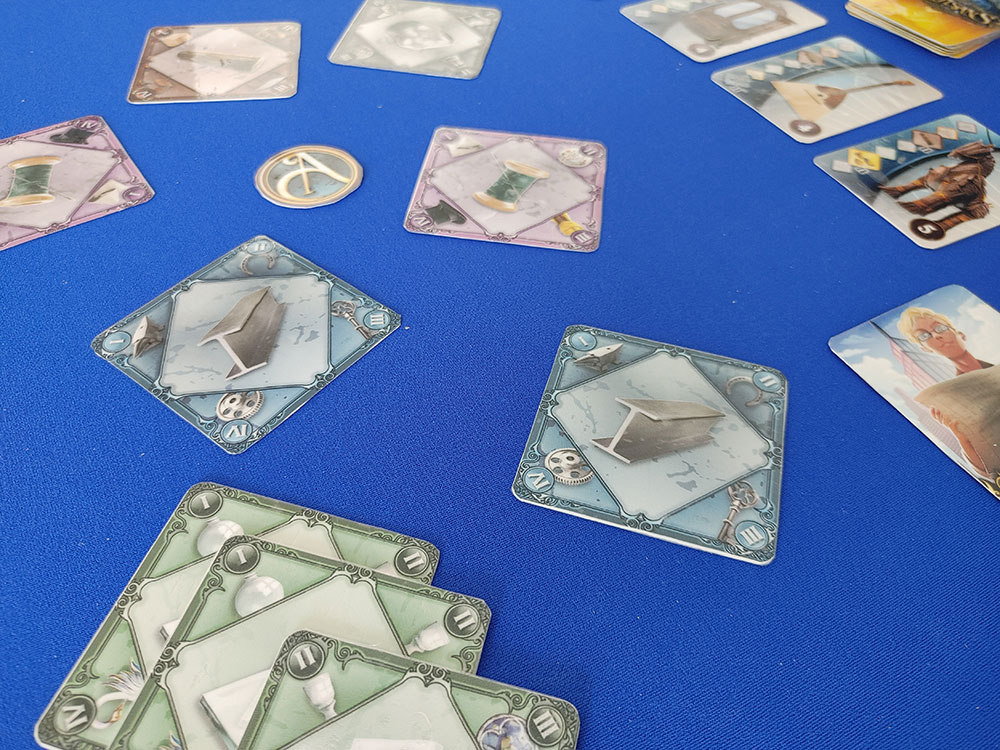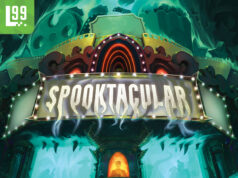Note: This preview uses pre-release components and rules. What you see here may be different from the final, published game. This post was a paid preview, you can find out more information here.
 For those looking to add a new family-weight entry to their gaming collection, an upcoming Gamefound campaign might be of interest. Artisans is a card game that launches on the platform on October 25. It’s designed by Segolene and Jean Paul Monnet and published by V Games.
For those looking to add a new family-weight entry to their gaming collection, an upcoming Gamefound campaign might be of interest. Artisans is a card game that launches on the platform on October 25. It’s designed by Segolene and Jean Paul Monnet and published by V Games.
In the game, players will become the titular Artisans and try to collect and then develop materials in order to craft art objects. The game is for 2-4 players and takes between 30 and 45 minutes to play.
Gameplay Overview:
Artisans is a drafting and set collection game with some contract fulfillment thrown in. At the start of the game, players will set up a market consisting of material cards that will be placed in a circle at the center of the table. There will also be four art cards revealed; these essentially represent the contracts players can fill once they have developed their materials to the appropriate levels. Players are dealt a hand of six material cards and a starting Artisan card that has a unique ability they can use throughout the game.

There are two phases to each of the game’s 12 months (rounds). In the Market Phase, players can either craft an Art card if they have the required materials developed in their tableau, or they can add a resource from the market into their hand. Players have a hand limit of six, however, and if they want to take an additional material card, they must put down a card from their hand and it can’t match either of the cards on either side of it in the selected market location. For the first two months of the game, players won’t have the necessary material development to select an Art card, so they must focus on the resources in the market. Players will take one of these two actions until someone selects the first player token instead of an available material, at which point that phase of the round ends.
The second phase every month is where players will develop their materials. This is done by selecting a material type from their hand and putting any number of these cards down in front of them. Players can only develop one resource during this phase every month.

The first time this is done, the material will be developed at level one. However, each subsequent time you develop that particular material the cards will be rotated and placed at level two and so on. The trick is that whenever you develop a material after level one, the number of cards a player can develop of that material must be equal to or less than the number that were put there at the most-recent development level. So, if a player only puts one resource card down for a level one development, they will only be able to be able to put down one level-two resource card on a later turn. This restriction creates an interesting decision space for players as they try to figure out the best way to maximize development. Players can put down a lot of level one and two materials early, but that risks slowing down their crafting engine in regard to the available Art cards.
Materials also score points based on their development level (level one resources are worth one point, level twos are worth two, etc.). Play continues this way for 12 months after which players will add up all the points on their developed resources and on their acquired Art cards to determine the winner.

Gameplay Impressions:
Artisans is centered around concepts that are very easy to grasp. Does a certain Art card look attainable on a future turn? Then a player can use that as the focal point of their strategy for a round or two. The way resource development works complicates this because it is challenging to not only get to the higher levels, but also the nature of the market draft is that other players can end this phase at any time, which might limit what their opponents are able to collect. This conceit is a neat design choice that comes across pretty well; it almost adds a push-your-luck element to the material drafting portion of the game.

Once players have really started to ramp up the levels at which their materials are developed, Art items start to get claimed more regularly, which gives the game a nice escalating element of tension as the year is coming to an end. There’s also a variety of individual player powers (9, to be precise) that really change the starting strategies from game to game. There’s a nice mix of what the powers do, but as an example, certain artisans will grant extra end-game points for players who craft items made with a specific material while other artisans will reward players for achieving the highest levels of material development.
Final Thoughts:
For an entry-level set collection and drafting game, Artisans is able to add some depth with its unique resource material mechanic. The game is very easy to learn and plays quickly, making it a good fit for both casual and experienced gamers alike. The variety in Art cards and Artisan starting characters also offer a good deal of replay value so no two games will have quite the same feel.
If this game looks like something that is a good fit for you and your gaming group, follow the Gamefound campaign page and see all the updates before it launches on October 25th. Artisans will also be available to play at Essen Spiel 22. Players can visit booth 1A114 to not only see the game in action, but also try it out for themselves.






















Thanks a lot for this nice review !!!